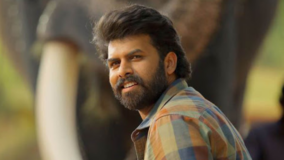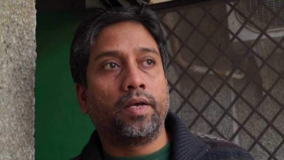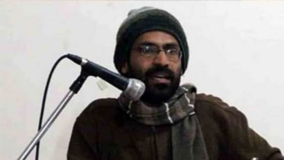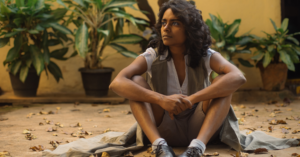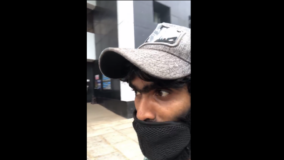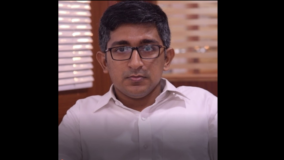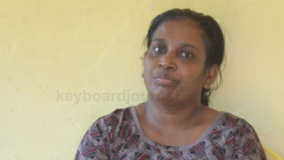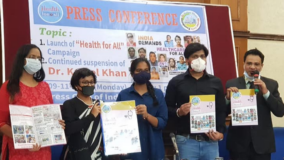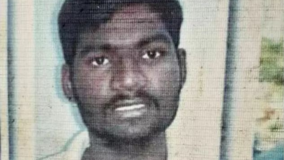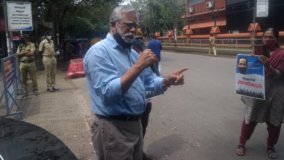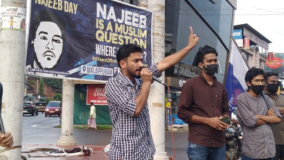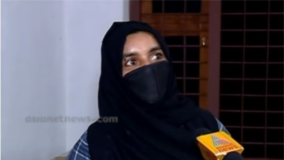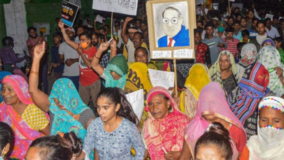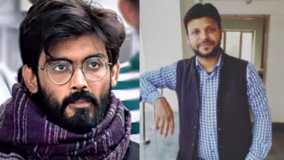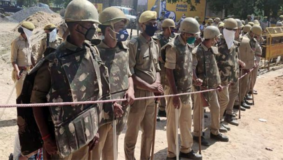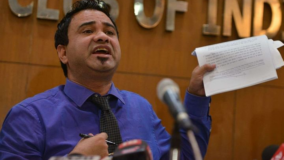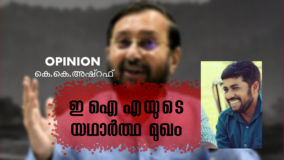
Shailaja Padindala’s ‘Vote Haaki’, a searing work hinting at a futuristic gender sensitive abode
There is no doubt that to think of handling queer content realistically in Indian cinema would be difficult. Many film makers- male, queer, female from various Indian languages have tried at it, done it, mostly not being very direct about carrying such themes and addressing it as it is. But, most of these expressions made by our previous generations were hidden. The voices were fragmented, and trying to find a place. Here, film director Shailaja Padindala comes up with a song ‘Vote Haaki’, giving more of hope about encountering the oppressive structures, rather than never talk about them openly. The song written and sung by Shailaja in Kannda, released on May 1, have a quirky rhythm and its lyrics are catchy.
“Bored minds are bowled over pictures and cinemas
after a great meal with perfect salt, spice and sugar, the mass have voted
Decades of Voting…Voting…Voting, has only bent the finger
Decades of Bending…Bending…Bending has further twisted the hand
King’s rule is all about Blah… Blah.. Blah
Men are not allowed to be feminine…blah
Women are not allowed to express freedom…blah…
But to vote wisely is not blah”
This song directly is a hit on the male dominated system, be it electoral, be it patriarchal in sexualizing women as a gender. When one closely looks at the song, the amount of awe it creates about the way in which the song has interwoven various themes is immense.
The song is produced by JLT films, Harini Daddala, in association with Moustache Under my Nose Ring. A short description given along with the video calls this song “an attempt to dissect the systematically woven link between caste emerging through patriarchy, patriarchy emerging through capitalism, capitalism emerging through fascism, fascism through feudalism and all of these controlling the freedom of sexuality, financial freedom, information, the vulnerable, and the women, through religion, class, caste, race, color and what not. Vote Haaki attempts to intersect through all divisions to unify the voices of paid and unpaid labour.”
Shailaja appears in the song wearing a khaki shirt and lungi, cheering and dancing along with a crowd, all expressing themselves without any hindrance. For the heteronormative world, Shailaja’s could be an unfamiliar body in an unfamiliar slot. That itself is unique about this song. In an interview given to Keyboard Journal, Shailaja Padindala talks about some of the key pointers of their art.
Can you tell us about being a queer person in the film making industry?
I’m a queer person. I am very androgynous, who does not fit into the hetero-normative understanding of film industry or glamour industry. My color, hairy body, all these are listed as errors. That was my biggest challenge ever since I was a child. I was very androgynous as a child itself, in my looks. As I grew up I understood that the heteronormativity was enthrusted against me and many individuals like me. The song is a culmination of all my experiences of being queer, putting it across in a very humorous way where we don’t cry being a victim but rather laugh at the system and proceed towards becoming aware.
In the entire world, it is only in the Indian industry and very few Asian countries there is a tradition of songs in film narrative. The cinema theatre industry audio revenue is a market and songs are structured around reaching all emotions. The industry has so far touched the emotion of kaamam with an item song, and the item being a woman made to sexualize her in order to express freedom.
The ‘item’ has to be a girl and it has to be all about sexualizing her. It is to break these gender stereotypes and the barriers that the society has put, I attempted to dance in the film wearing a lungi, being one who is nothing like a sexual object that the cinemas have known.
Why do you think the ‘item song’ so dominant?
The Indian industry can’t show the heroine as the ‘item girl’ herself. The heroine has to be very monogamous towards the hero. To boost the ego of the hero and his personality, they need to bring an ‘item’. The film industry is designed to bring a woman who will be free in her sexual expression, she becomes an ‘item’ because she doesn’t have a real role to play. Why is it a woman who is free in expression always been looked as a sexual object? The aspect of the song ‘vote haaki’ is how to portray freedom in a woman’s expression without sexualizing or desexualizing her.
I read in one of your interviews that working as a media person influenced your view as a film maker, that you realized the film can be more realistic. Afterwards, how do you approach film making in terms to it?
I started as a painter. My art journey began in Bangalore. Given the context of Bangalore, a very urbanized place where the culture is very diverse and you don’t see the native culture rather of an incorporated culture of Hollywood, Bollywood or such stuff. Being bred by such an isolated idea of culture, later when I went to study in Chennai, where nobody spoke any other language than Tamil and where they make sure that the outsider learns Tamil. This changed entirely how I look at myself.
I am half Anglo-Indian and half Telugu from Andhra Pradesh who is brought up in Bangalore. In the place where I grew up there was not much acceptance for my color, the subject of my art, my queerness, my sexuality, my expression, I was always looked at as an error. But in Chennai’s acceptance for my queerness, my color, my expressions brought me to learn the language. I understood the Dravidar culture as my own. This is when the idea of art came out, from being a painter I went into film, especially with cultural luster that I brought from Chennai.
I see that the craft is secondary aspect of an art expression; primary aspect is the content and its politics. I realized this while I was working in the media as a journalist. I worked as video producer for Puthiyathalamurai where we created a lot of stories of common people in a programme called ‘IngeYennaIllai’, in the mentorship of late BalaKailasam sir, (son of K Balachander). It was all about looking at the error, embracing the reality and it is about the issues of common man, this is what I understood coming from painting and after learning cinema. Drama and craft is a very small element of an expression. The political aspect and the content have to be real. This is what I learnt in journalism narrative of visual. Then onward, like you see in my ‘Memories of a Machine’ I carry that sort of a dogmatic narrative.
South Indian states have specific history of queer sensibility and visibility. How do you think art in a way have helped in reaching that space? How do you think the art have helped it?
I think South India has a great magnitude of education, literacy in history of literature. Its culture itself is very innate. The few queer bollywood films such as ‘Fire’ left me confused if the women in the film were falling love with each other because no men gave them attention, which was not my understanding. Queerness has been very sensibly addressed in Dravidian cinemas. Though we recognize the movie ‘Fire’ as the first Indian queer film, ‘The Journey’, Sancharam, a Malayalam film had more realities of queerness addressed. From there on, you see the queerness and gender sensibilities very beautifully woven into cinemas, like in Kumbalangi Nights, The great Indian kitchen, Super Deluxe etc. It beautifully expands the role of a woman. You see it in the shots where Soubin Shahir bringing his friend’s wife to a home of men and him cooking for her. She is one of the community members like the other men at home. I think the Bollywood is still trying to find their identity in cultural sciences, cinema and arts.
How this song is being received?
People are loving the tune, I guess it is catchy. I heard a few malayalis humming the Kannada lyrics. And I feel so happy to see the point where all Dravidians of different languages unite.
But a few have commented that the camera could’ve been like this, like that. ‘Vote haaki’ is about embracing an error, there are so many errors that glamour world won’t accept. If there is a technical limitation, that too is being woven within narrative. I got this inspiration from Dutch film maker Lars Won Trier. He is the person who started bringing production technique called dogma, where everything is spontaneous and as it is. If there is a limitation in the situation don’t cover it up or make up, you embrace it within the narrative. Again he is a Dutch film maker, European cinema narrative is completely different from Indian cinema narrative. I wanted to use that kind of technique that Lars Won Trier has used over the Indian narrative.
